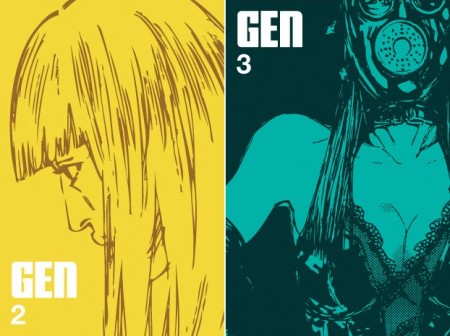Gen Issues 2 & 3 Review
The striking, stark and powerful cover images of Gen Manga issues 2 & 3 immediately inform readers that what these books contain is not necessarily the typical mainstream, mass consumption manga that readers may be most familiar with. Gen Manga issues 2 & 3 continue to serialize the four stories begun in issue one. While these subsequent issues reveal some development from the first issue, some of the weaknesses of the first issue also persist.
While none of the four stories serialized in Gen Manga can be called especially unique because all of them draw inspiration from earlier Japanese works, Shige Nakamura’s “Wolf” is the strongest of the stories, not because it’s especially original but because it’s the most fleshed out. As the story expands in issues two and three, new characters are introduced, and the narrative gets more interesting as backgrounds are revealed and characterizations become more developed. For a retro boxing manga, “Wolf” is interesting because it draws more inspiration from the narrative and drawing styles of particularly Fujio Akatsuka and Ikki Kajiwara than from Tetsuya Chiba, its presumed most obvious inspiration. Readers used to contemporary manga may find “Wolf” old-fashioned, but readers that can appreciate its contemporary awareness mixed with reverence for 70’s sports manga should find it quite interesting. Particularly the second issue’s installment introduces a lot more profanity, but the language is all natural and appropriate in context. The second issue’s installment also allows a few translation typos to slip in, including “practive menu” instead of “practice menu” and “with you hand” instead of “with your hand.” The translation in this particular story, unlike the other stories contained in Gen Manga, at times sounds just a bit stilted, but the oddity is minor enough to cause only momentary distraction.
Yu Suzuki’s “Vs Aliens” story is the most kindred to contemporary teen manga, which may make it attractive to readers but also makes it flaws most evident. The story unfolds more slowly, as if it wants to spend more time focusing on its three characters, but instead of revealing anything substantial about its cast’s personalities, the narrative spends its time on superficial trivialities. The narrative development is also weakened by uneven and amateurish development including a cliffhanger in issue three that seems artificially abrupt and unnatural. The art is issue two’s chapters seems especially rushed and careless, evoking the design of a 90’s American indie comic attempt at mimicing Japanese manga. The art in issue’s three’s chapters is cleaner and stronger. Noticably unlike standard practice in Gen Manga, one large panel in issue two’s installment contains a noticable sound-effect translation directly in the panel instead of outside of the artwork. Issue two’s chapters also allow the distracting typo “You can bet they she has a plan,” to slip in.
Gunya Mihara’s fantasy adventure “Kamen” continues to be enigmatic through issues two and three, despite issue two containing a longer than normal installment. The art continues to look nice, although a few drawings of castle walls look like they were drawn with a ruler, which makes them distinctly stand out against the surrounding art’s more rough and evocative look. The character name “Olnela” is distractingly spelled “Onela” the first time it’s introduced, and the typo “”Hiuman language” slips through unchecked. “Kamen” continues to seem like the dark horse of the collection, but readers will have to wait until further issues to determine whether it will develop into something great.
Even more so than the first issue, the art design and use of screen-tone in Arisa Karino’s “Souls” story is lush and gorgeous in its second and third installments. However, the art still suffers from a poor sense of proportion resulting periodically in characters with too-small heads or slightly deformed facial features. This supernatural story of a troubled love between a mother and daughter wants to be very incisive and affecting, but its effectiveness is partially hamstrung because the author’s dialogue and narrative development seem to partially forget that while the writer knows this story inside and out, the readers do not. So motivations and plot developments aren’t always presented literally, forcing readers to guess and interpret from context. Furthermore, extensive use of floating dialogue makes distinguishing who’s saying what difficult to do. The fact that both mother and daugher have similar psychological scars makes the dialogue even more difficult to properly attribute. So instead of immersing in the story and sympathizing with the charactes, readers spend their time trying to analytically process what’s going on and who is saying what. I respect Karino’s goals, but I guess that inexperience with visual storytelling results in her manga having a stronger concept than execution. Translation typos including “Thety all looked down,” “Please listen to be for a moment,” and, “Too much time has past since,” instead of “Too much time has passed since,” also distract a bit.
With its second and third issues, Gen Manga continues to challenge manga publishing convention in America, and for that, the magazine deserves commendation. Gen Manga issues two and three, like the first issue, may not suit the tastes of all American manga readers. But Gen Manga does an excellent job of exposing Americans to another facet of Japanese manga and offering American readers the opportunity to read brand new grassroots manga. These early issues demonstrate growth and development from both the publisher and the manga artists represented. It’s rewarding to experience and support this fledgling effort, and I’m sure that the minor flaws will iron out with more experience and future issues.
Add a Comment
You must be logged in to post a comment.




